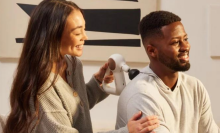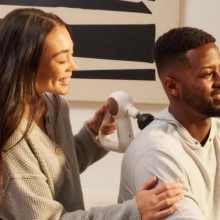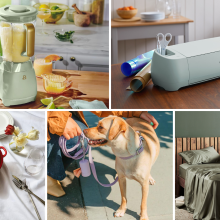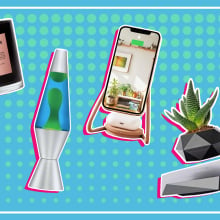Being a product reviews editor, I often have neat gadgets in my apartment, whether I’m testing them or was just influenced by another writer to buy them. I currently have a new reigning champ for the coolest thing in my home: the Tempur-Ergo smart base. Apologies to the previous title-holder, the TheraFace PRO.
I was initially interested in the Tempur-Pedic smart bed because it has sleep tracking similar to the kind you’d get from a wearable (and yes, the built-in massage feature also piqued my interest). I wanted to try it out to see if a bed frame could actually give me insights into my sleeping habits.
While the Tempur-Ergo smart base is pricey for a bed frame (it retails for $1,949 for a queen), I was sold after sleeping on it for two months.
What makes the Tempur-Ergo smart base special?
Obviously, this is not your average bed frame. The Tempur-Pedic smart bed raises at the head and foot and has under-bed lighting, USB ports on both sides, head and foot massage zones, snore response, sleep monitoring, and sleep coaching. I was also able to set an alarm that would vibrate the bed to wake me up during my lightest phase of sleep within a customizable time window.
The guys who delivered the bed frame assembled it, so I didn’t have to do any heavy lifting or difficult assembly. The only manual setup I did was crawl under the bed to activate the sleep sensor. While it was a bit inconvenient, I only had to do it once.

Exploring the smart frame’s features
I tested the Ergo frame with the Tempur-Breeze mattress (though you don’t have to have a Tempur-Pedic mattress to use the base). Once everything was set up, I immediately hit every button on the included remote and played around with all the features in the smartphone app.
I was able to adjust the head and the foot of the bed to inclines of my choosing, or select one of the presets. The zero gravity preset raises the head and food of the bed (to the point where the bed is folded up like a taco shell) to make you feel weightless and take pressure off your back while you sleep, while the TV setting raises the head of the bed so you’re sitting upright. I found the TV position to be a little too perpendicular, so I stuck to the manual adjustments when I wanted to sit up in bed to read or watch TV. The zero gravity setting was nice when I just wanted to chill in bed, but as a side sleeper, I can’t imagine sleeping in that setting — I practically gave myself scoliosis trying to lie on my side while the bed was contorted into the zero gravity position.

As I said earlier, the massage feature was really appealing to me. On the remote, there are three full-bed massage levels and two levels each for the head and the foot of the bed. I’ll be real, it’s more of a vibration than a massage. The bed frame is doing the work, so it might not feel like a powerful massage if you have a thick mattress. I’d describe the sensation more as white noise for your body, which was quite enjoyable to fall asleep to (I’m an avid brown noise listener). One gripe I have with the massage feature is that the vibration pattern would randomly skip a beat now and then, which would jolt me awake if I was on the verge of falling asleep. The massage zones automatically turn off after 30 minutes though, so you don’t have to worry about the motor burning out if you fall asleep or forget to turn it off.


Additional features on the remote that I didn’t use as much include the under-bed light (which I would have used more if I didn’t have Hue smart bulbs that I can control from my phone) and the anti-snore position. Something I appreciate about the remote is that it has a button that returns all the settings to neutral.
In addition to the physical remote control, there’s a remote within the app, but I had issues with it multiple times where it just wouldn’t work no matter how many times I tapped the buttons. I made sure to keep the actual remote within reach as a backup. You can also set up voice control with Google Assistant or Alexa.
Tracking sleep with the Tempur-Ergo smart base
Sleep tracking is what sets the Tempur-Ergo apart from other adjustable bed frames — and the feature I was most excited to try. I used to love tracking my sleep with my Fitbit Blaze, but I lost the functionality when I switched to the Apple Watch Series 3, which doesn’t have built-in sleep tracking and relies on the Apple Health app to provide pared-down metrics.
The Tempur-Pedic smart base’s sleep tracking blew me away. I’m still having a hard time understanding how a bed frame can capture these kinds of sleep insights. Obviously, the downside of depending on your bed frame to provide sleep tracking is that you don't get metrics when you travel or sleep somewhere else.
I suck at going to bed on time
To get started, I set my sleep goals, including what time I wanted to fall asleep, what time I wanted to wake up, and how many hours of sleep I wanted to get each night. I set my bedtime at midnight, so every night at 11:45, I got a notification on my phone from the Sleeptracker app to get ready for bed. I wish I could set different bedtimes for the weekend because I’m not usually in bed by midnight most weekends. But the whole idea of sleep tracking is to keep you on a consistent schedule for your circadian rhythm, so I get it.
It took me a week or two to figure out what a realistic bedtime and wake-up time were for me because I kept missing the windows I set. It was also frustrating that if I went to bed early or woke up early — which are often big accomplishments for me — the app gave me a light scolding reminding me to only sleep within my set times. It’s kind of embarrassing how few times in the last couple of months I hit my target sleep schedule.

I sleep alone most nights, but if you share your bed, you’re able to set up different sleep goals and tracking for each side of the bed.
Which sleep metrics are tracked
The smart bed frame tracks a boatload of sleep metrics — way more than my early-model Apple Watch is capable of. Every morning within an hour of getting out of bed, I get a personalized report showing me total sleep, sleep quality, percentage of sleep goal, deep sleep, light sleep, REM sleep, fell asleep time, number of wake-ups, time spent awake, sleep efficiency, heart rate, and breath rate.
I can see weekly views of my sleep schedule and whether I met my target sleep/wake-up times. And there’s a calendar view that shows the days I got good sleep quality and low sleep quality. I even have access to an AI sleep coach that provides some extra context and information such as trends in my sleep habits and tips for sleeping better. The bed only tracks nighttime sleep and doesn't provide insights for naps like a wearable would.


The bed frame also monitors my bedroom’s environment, which is not something I expect to come standard with a sleep tracker. In the app, I can see my room’s air purity, carbon dioxide levels, humidity, and temperature.
Apparently, I snore
My mom and brother are the loudest snorers I’ve ever heard, but I pride myself on not snoring. No one has ever told me I snore…until this bed. I was shocked after the first night on the bed when I looked at my breathing pattern and saw a whole bunch of blue spikes that indicated snoring.
At first, I thought those spikes were either baby snores or deep breaths. I set the bed frame to gently vibrate if it detected snoring (you can also choose for it to move you into an anti-snore position) and never noticed any vibration. I questioned whether the feature was working properly or if I was just breathing heavier at some points throughout the night. My answer came during month two after a night of heavy drinking. When I woke up, my sleep chart showed that the bed had activated the Smart Snore Pulse three (!) times and my little blue snoring ticks almost created a solid line across the chart. So now I know, doing bottomless brunch and rallying until 2 a.m. is the secret sauce to making me snore so loudly my bed has to get involved
A week or so later, I had a cold and was congested (probably from the binge drinking), which also resulted in some Smart Snore Pulse-worthy snoring. During this time, I unlocked another new icon on my chart showing that I had a restless period in the wee hours of the morning that I have no memory of. Note to self: Don’t get sick or drunk if you want good sleep.


Like with most widely-available, non-medical grade sleep trackers, I’m not accepting all of these metrics at face value. But they do seem impressively accurate for something that’s not even touching my skin while I sleep.
Is the Tempur-Ergo smart power base worth it?
I was super excited to test the Tempur-Ergo bed frame and it lived up to — if not exceeded — my expectations. I did have a couple of nights where the bed randomly went offline and didn’t track my sleep, so that was annoying, but it wasn’t frequent enough to be a real problem for me. Overall, the bed frame was packed with cool tech and I found myself poring over the metrics in the app every single day.
There are plenty of adjustable bed frames out there, but not many track your sleep and coach you on how to improve it. The closest competitors would be Sleep Number’s Sleep IQ smart beds and the Intellibed Sleep Genius smart base. Tempur-Pedic has four adjustable bases, two of which include sleep tracking. The more advanced Tempur-Ergo Extend base offers a few additional features (four massage zones instead of two, PerfectSeat, and pillow tilt) for $2,549.
The Tempur-Ergo smart base does cost about $2,000, but so does my 14-inch MacBook Pro, and I don’t sleep on that thing every night. Obviously, not everyone has the luxury or need for a $2,000 bed frame, but mattresses are supposed to last about 10 years, and I can see this bed frame having a long lifespan as well, so it is a worthy investment.
Topics Health Reviews Mashable Choice























